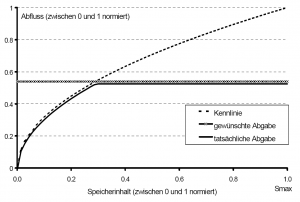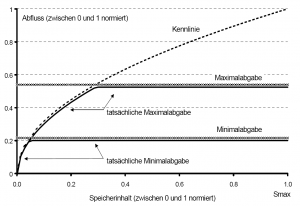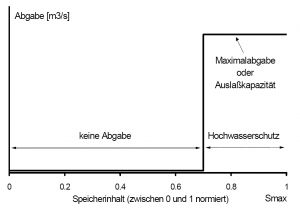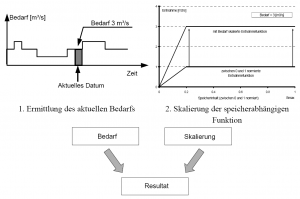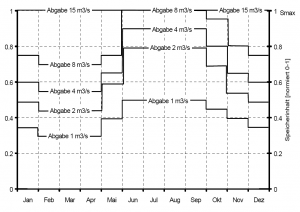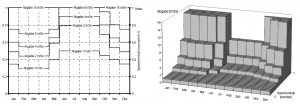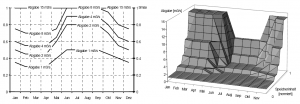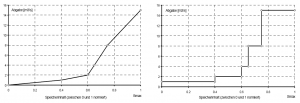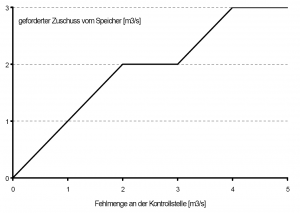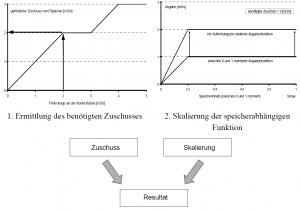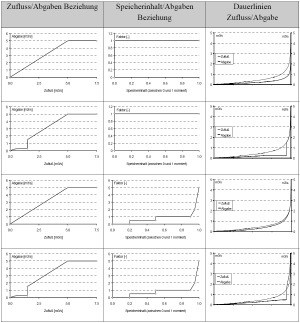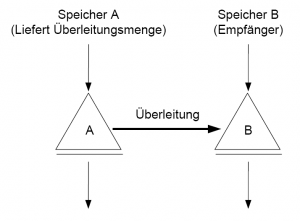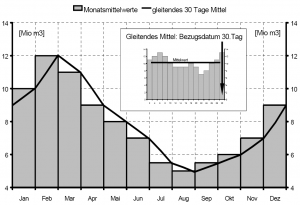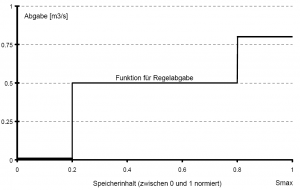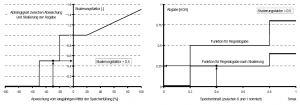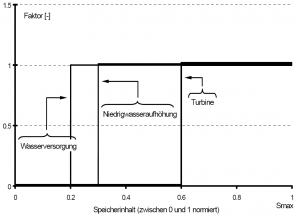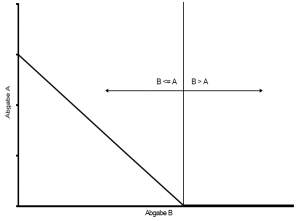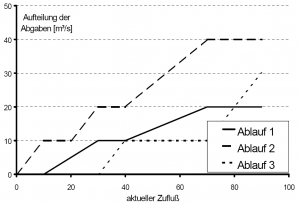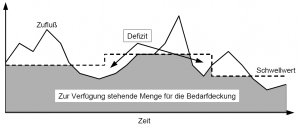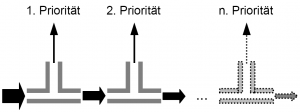Betriebsregeltypen/en: Unterschied zwischen den Versionen
Ferrao (Diskussion | Beiträge) (Die Seite wurde neu angelegt: „:All reservoirs with a direct influence on the control point receive a missing quantity/factor and a content-dependent scalable function according to :Datei:…“) |
Keine Bearbeitungszusammenfassung |
||
| (257 dazwischenliegende Versionen von 3 Benutzern werden nicht angezeigt) | |||
| Zeile 3: | Zeile 3: | ||
{{Navigation|vorher=|hoch=Betriebsregelkonzept|nachher=Abstraktion der Betriebsregeln}} | {{Navigation|vorher=|hoch=Betriebsregelkonzept|nachher=Abstraktion der Betriebsregeln}} | ||
The operating plan of a dam or a storage network | The operating plan of a dam or a storage network is part of the official approval of plans and usually is available as a report or presentation. Its complexity can vary: it ranges from simply defining flood protection areas and setting a report and alarm plan to notify the supervisory authorities in exceptional situations to complex sets of rules concerning functional dependencies that derive discharges from varying system states. | ||
As follows, principles to clarify the variety of possible regulations and reduce them to essential dependencies are presented. A concept is derived to represent most operating rules by a few basic calculation rules. The given selection does not claim to be complete, but it is likely to contain the rules applied in practice. | |||
==Principle: Verification of | ==Basic Principle: Verification of Physical Limits== | ||
[[Datei:Theorie_Abb1.png|thumb|Figure 1: | [[Datei:Theorie_Abb1.png|thumb|Figure 1: Dependency on storage capacity]] | ||
When specifying | When specifying discharges according to an operating rule, it is assumed that the outlet capacity is sufficient to meet these discharges. Thus, dimensioning the outlet element must consider the operating requirements. In principle, the physically possible discharge, given by the outlet's characteristic curve at full opening, sets the upper limit value. | ||
If the pressure level or the capacity | If the pressure level or the outlet capacity is sufficient to discharge the desired quantity when fully opened, the discharge can be throttled to the intended level by closing a slide. If the pressure level is insufficient, only the hydraulically possible discharge can be discharged. | ||
*Mathematical abstraction: | *Mathematical abstraction: | ||
:All outlets | :All outlets obeying an operating rule are functions of the storage's volume and cannot exceed the outlets' maximum capacity when fully opened. As soon as the capacity of the outlets exceeds the required discharge, it can be adjusted by partially closing the control elements. | ||
All | All discharge types from storages mentioned below are subject to this restriction. | ||
==Rule | ==Rule Type 1: Definition of a Minimum Output or a Safely Dischargeable Maximum Output== | ||
[[Datei:Theorie_Abb2.png|thumb|Figure 2: Example for minimum and maximum discharge as a function of storage capacity]] | [[Datei:Theorie_Abb2.png|thumb|Figure 2: Example for minimum and maximum discharge as a function of storage capacity]] | ||
* | * Dependency: | ||
:The specification of a minimum or maximum | :The specification of a minimum or maximum discharge is based on requirements downstream of a storage. The maximal discharge is based on the discharge respective to a critical, downstream cross-section. Consequently, a hydraulic method exists for its determination. In contrast, there is no clear guideline for the minimum discharge. Often, ratios of MNQ or MQ are used. Independent of determining the minimum or maximum discharge, the basic principle to verify outlet elements' physical limits is applied. So, minimum and maximum discharge can only be discharged if the outlet capacity is sufficient at the given pressure level. Since, in reality, it is unlikely that the dimensioning of the outlet elements and the required discharge are conflicting, the reference to the dependence on the storage capacity content is rather theoretical but necessary to derive general laws. | ||
* Mathematical abstraction: | * Mathematical abstraction: | ||
:Minimum and maximum discharge are functions of the | :Minimum and maximum discharge are functions of the storage volume and follow the characteristic curve of fully opened outlets at a low filling level. As soon as the outlet elements' capacity is sufficient for the required discharge volume, the discharge can be kept constant by partially closing the control elements. | ||
==Rule | ==Rule Type 2: Maintaining a Flood Protection Area, Possibly Timely Variable Over the Year== | ||
[[Datei:Theorie_Abb3.png|thumb|Figure 3: Example of a function | [[Datei:Theorie_Abb3.png|thumb|Figure 3: Example of a function to maintain a flood protection area]] | ||
* | * Dependency: | ||
The definition of a flood protection area | :The definition of a flood protection area as a minimum requirement only includes the designation of a volume, which has to be kept free for potential floodwater. The dimensioning is based on flood events with certain recurrence intervals. If the water level exceeds the mark of the protection area, an increased discharge to the downstream water of the storage ensures that the area is kept empty. Thus, this rule is reduced to a relation between discharge and storage volume, where the outlet capacity or a defined maximum discharge can serve as an upper limit for keeping the flood protection area empty. If the flood protection area is variable in time over the year, only the discharge of the respective storage volume is increased. | ||
* Mathematical abstraction: | * Mathematical abstraction: | ||
: | :There is a direct relation between storage capacity and release. If the storage capacity exceeds the mark of the flood protection area, a discharge occurs. If it remains below the mark, the discharge is set to zero. | ||
==Rule | ==Rule Type 3: Direct Withdrawals from a storage for Drinking or Service Water == | ||
[[Datei:Theorie_Abb4.png|thumb|Figure 4: Example of a function for drinking or raw water withdrawal]] | [[Datei:Theorie_Abb4.png|thumb|Figure 4: Example of a function for drinking or raw water withdrawal]] | ||
* | * Dependency: | ||
Primarily the current demand determines the | :Primarily, the current demand determines the volume of withdrawals from the storage, but it is also subject to temporal variations. The upper limits for withdrawals are generally set by water rights or defined maximum withdrawal volumes, which refer to selected periods such as a day, a month, a quarter, or a year. Initially, one only considers the current demand communicated by water suppliers, which constitutes a claim towards the storage. There is no connection to the actual storage and the respective storage volume. | ||
:Whether the demand can be pleased by withdrawing water from the storage is determined by the actual storage volumes. To connect the water demand to the actual storage volumes, the structural implementation of withdrawal elements and means of anticipatory management are taken into account. For example, if particularly low storage volumes are reached, it is advisable to throttle withdrawals in advance to avoid the storage running empty and then completely failing at covering the demand during prolonged periods of low water <ref name="Schultz_1989">'''Schultz, G.A.''' (1989): Entwicklung von Betriebsregeln für die Wupper-Talsperre in Niedrig- und Hochwasserzeiten. Wasserwirtschaft 79 (7/8) S. 340-343</ref>. Hence, there is usually space reserved in a dam specifically used for drinking water supply. Its use is handled separately in respective operating plans. | |||
* Mathematical abstraction: | * Mathematical abstraction: | ||
:If the demand is exactly known and unchangeable, a direct relation between withdrawal and storage | :If the demand is exactly known and unchangeable, a direct relation between withdrawal and storage volume can be defined. However, the demand is subject to certain variations. For this reason, it is recommended to normalize the relationship between withdrawals and storage volume, where the current demand serves as a scaling factor. If the storage volume falls below a defined limit value, only a certain percentage of the current demand is satisfied. The limit value, as well as the form of the function, can be variable in time. | ||
==Rule | ==Rule Type 4: Standard Discharge to Downstream Water== | ||
[[Datei:Theorie_Abb5.png|thumb|Figure 5: Pool-based operating plan in | [[Datei:Theorie_Abb5.png|thumb|Figure 5: Pool-based operating plan in a two-dimensional representation]] | ||
* | * Dependency: | ||
:The | :The normal discharge to the downstream water should provide a discharge compensation for seasonal differences in the inflow. If a minimum discharge is required, it will be included in the normal discharge. A pool-based operating plan is used to describe the normal discharge. It divides the storage capacity into different areas and assigns a discharge to each pool-based operation. When determining the pool-based operating plan, the long-term discharge and other withdrawals from the storage for other purposes play a decisive role. A storage should collect water in periods of high inflow but still not overflow to have sufficient reserves in periods of low inflow. The coupling of the releases to the storage pool-based operation is a function of the storage volume. Since the system is supposed to react to variations of inflow during the year, the relationship between storage volume and discharge is usually variable over time. | ||
* Mathematical abstraction: | * Mathematical abstraction: | ||
:[[Datei:Theorie_Abb6.png|thumb|Figure 6: Comparison of a pool-based operating plan in | :[[Datei:Theorie_Abb6.png|thumb|Figure 6: Comparison of a pool-based operating plan in a two- and three-dimensional representation]] Like for the previous rules, the output depends on the storage volume. Usually, a pool-based operating plan is displayed in two-dimensional diagrams. The X-axis shows the time of one year, while the Y-axis shows the storage capacity. Pool-based operations are depicted as lines of equal outputs. | ||
:[[Datei:Theorie_Abb7.png|thumb|Figure 7: Pool-based operating plan with linear interpolation between successive time reference points]] | :[[Datei:Theorie_Abb7.png|thumb|Figure 7: Pool-based operating plan with linear interpolation between successive time reference points]]This view is practical but not yet complete: A three-dimensional representation of a simple pool-based operating plan makes this clear. On the X-axis is the time, on the Y-axis the storage capacity is plotted, while the Z-axis shows the output directed upwards. | ||
:The 3D image viewed | :The 3D image viewed from above gives the two-dimensional shape. Instead of taking constant blocks for the individual time horizons, a linear connection is also used often. | ||
:[[Datei:Theorie_Abb8.png|thumb|Figure 8: Pool-based operating plan with two types of interpretation (selected month of May)]]For the individual | :[[Datei:Theorie_Abb8.png|thumb|Figure 8: Pool-based operating plan with two types of interpretation (selected month of May)]]For the individual periods - here months - different functional dependencies between storage capacity and outflow are considered. If the storage volume/discharge relation is also considered for a selected point in time, there are two possibilities to connect the discharge nodes. On the one hand, there is the possibility of linear interpolation, and on the other hand, a step function is possible. | ||
:In two-dimensional space this information is not visible and must be specified separately. However, there is usually the convention to assume that the output between two nodes is constant, i.e. to interpret the | :In two-dimensional space, this information is not visible and must be specified separately. However, there is usually the convention to assume that the output between two nodes is constant, i.e. to interpret the pool-based operating plan as shown above in the form of steps.<br clear="all" /> | ||
==Rule | ==Rule Type 5: Maintaining Defined Discharges to Downstream Waters (Increase of Low Water / Coverage of Demand)== | ||
[[Datei:Theorie_Abb9.png|thumb|Figure 9: Example of a function between | [[Datei:Theorie_Abb9.png|thumb|Figure 9: Example of a function between shortfalls and scaling factors for a storage | ||
]] | ]] | ||
* | * Dependency: | ||
:In this case the current | :In this case, the current discharge is determined by conditions downstream of a storage. At a cross-section of a water resources system, the so-called ''control point'', where the flow is dependent on the discharge from the upstream storage, a minimum flow is defined. The flow at the control point is composed of the discharge from upstream storages and the lateral inflows between the storages and the control point. If the current flow remains below the set minimum, an additional discharge from upstream storages is necessary. The volume of the additional discharge depends on the difference between the previously defined target flow and the actual flow. Whether the required discharge can be fully provided from the storage depends on the currently available stored volumes in the storage. The lower the level, the less favorable it is to provide additional water. In this context, the increase of low water/coverage of demand behaves completely identical to the drinking or service water withdrawal, with only the triggering factor differing. As mentioned before, a storage-dependent function is scaled by a factor, but this factor is now derived from a comparison between set values and current discharges. | ||
* Mathematical abstraction: | * Mathematical abstraction: | ||
The determination of the discharge | :The determination of the additionally needed discharge is composed of several factors. Firstly, a volumetrically varying shortfall of water results from failing the target discharge. The shortfall of water is then implemented as a scaling factor to the discharge which can be defined by a function. The shortfall of water functions independently, while the scaling factor functions dependently. | ||
[[Datei:Theorie_Abb10.png|thumb|Figure 10: Example of a function for increasing low water levels or meeting demand]] | [[Datei:Theorie_Abb10.png|thumb|Figure 10: Example of a function for increasing low water levels or meeting demand]] | ||
:Secondly, it depends on the actual storage volume, if and how an additional discharge from the storage can be met. A normalized volume-dependent function and the needed discharge lead to a clear determination of the additional discharge volumes. The following [[:Datei:Theorie_Abb10.png||Fig. 10]] shows an example, where the complete provision of an increased target can only be achieved if the filling level of the storage is above a critical limit (25%). | |||
If more than one storage | :If more than one storage has an influence on the relevant control point or if, in principle, more than one storage facility is to be used to meet the demand, the required additional discharge is to be divided between the storages in accordance with the corresponding regulations. A distinction must be made between the direct and indirect influences of a storage on the control point. A direct influence is present if a discharge can have a direct effect on the flow conditions at the control point, i.e. the natural flow between the storage | ||
and the control point can no longer be changed by regulation. If this is not the case, an indirect influence is given. | |||
:All | :All storages with a direct influence on the control point receive a shortfall factor and a volume-dependent, scalable function according to [[:Datei:Theorie_Abb10.png|Figure 10]]. Thus, depending on the shortfall quantities and the storage capacity, the actual discharge can be determined separately for each storage. | ||
== | ==Rule Type 6: Discharge Depending on the storage Inflow== | ||
* | * Dependency: [[Datei:Theorie_Abb11.png|thumb|Figure 11: Direct dependency between storage and control point]] | ||
: | :There is a direct dependency between the discharge from the storage and the current inflow to the storage. Similar to the pool-based operating plan, there is also an adaptation to different inflow situations. This is done to prevent depletion or overflowing or to obtain a variable discharge regime downstream. However, long-term inflow fluctuations are difficult to detect with this operating rule, since the observations are only carried out as snapshots and not continuously. | ||
: | :To determine an inflow-dependent discharge, several components have to be considered. First of all, a relation between the current inflow and discharge must be defined. In addition to the current inflow, the current storage volume is important, because the relation inflow/outflow must not be valid for every filling level. Thus it is likely that the relation is ceded completely or the release quantities are adjusted if the storage level falls below a critical level. | ||
: | :As this rule can lead to the co-occurrence of relatively small storage volumes and high inflows resulting in high discharge volumes, special attention must be paid to the basic principle of checking the physical limits. | ||
* | * Mathematical abstraction: [[Datei:Theorie_Abb12.png|thumb|Figure 12: Example of functions for inflow-dependent discharge]] | ||
:In | :In this case, three functional dependencies play a part. First, there is a direct dependency between the current inflow and the discharge. The form of the function can be arbitrary. It is possible to reproduce only individual sections of the inflow, which corresponds to a partial approximation of the discharge to the duration curve of the inflow. | ||
: | :Second, the inflow/discharge function can be superposed with the relationship between storage volume and discharge. For reasons of clarity, it is recommended to work with a normalized function. This makes it possible to influence the result of the inflow/discharge function for each storage volume, which is especially convenient for low filling levels. | ||
: | :Finally, the required discharge has to be checked with regard to the outlet elements' capacity. | ||
:[[Datei:Theorie_Abb13.png|thumb|left| | :[[Datei:Theorie_Abb13.png|thumb|left|Figure 13: Results of different inflow-dependent release strategies]] | ||
: | :The examples below show how the interaction of different functions affects the discharges. The results are compared in the following figures as inflow and discharge duration lines. | ||
: | :In the case of a linear relation between inflow and discharge and a constant factor for the storage volume, the duration line of the discharge is a curve corresponding to the inflow reduced by a certain percentage. If the storage volume factor remains constant, the duration line can be changed by varying the inflow/discharge relationship. An additional modification of the factor via the storage volume has the advantage of being able to respond to certain filling levels to prevent the storage from emptying or overflowing. | ||
<br clear="all"/> | <br clear="all"/> | ||
== | ==Rule Type 7: Influence of Discharges Trough System States== | ||
* | * Dependency: | ||
: | :Rule 7, just as rule 6, is a continuation and generalization of the increase of low water as described in rules 5. Just like a discharge deficit at a cross-section or the storage inflow can influence the discharge, any other system state can. In general terms, this means that a discharge from a storage is triggered, increased, or reduced due to a certain system state. Basically, it is irrelevant where the system state occurs. All measurable variables that influence the transport and storage of water can be considered as system states, e.g. the filling of other storages, discharges, flow regime at a cross-section, a snow depth in the catchment area, current precipitation, or current soil moisture. | ||
: | :As a requirement to apply those dependencies a detection of the system state is necessary. Practically, this means either that a measuring device must be available to determine needed parameters or the required values are calculated using a mathematical model. Parameters are only considered as snap-shots and not continuously. | ||
: | :If several system states should influence the discharge, a superposition of the parameters according to a corresponding regulation is necessary. | ||
* | * Mathematical abstraction: | ||
: | :Mathematically, the influence of system states on the discharge can always be undertaken by scaling. Two functions are necessary for this. The first function describes the relationship between storage volume and discharge. The second one controls the dependency between the system state and a scaling factor. The connection is done by multiplying the discharge with the scaling factor. | ||
[[Datei:Theorie_Abb13.5.png|thumb| | [[Datei:Theorie_Abb13.5.png|thumb|Transition]] | ||
: | :A simple example is given by a transition from storage A to storage B. | ||
: | :The decisive discharge is the transition from A to B. The considered system state is the storage volume of B. It seems obvious that a discharge from A to B is only useful if storage A has sufficient provision and storage B has sufficient capacity to hold additional water. This results in the following simple functions: | ||
:[[Datei:Theorie_Abb14.png|thumb|left| | :[[Datei:Theorie_Abb14.png|thumb|left|Figure 14: Example functions for linking a system state to a discharge]]storage B takes 100% of the discharge from A as long as its filling level does not reach 70% of the maximum volume. Furthermore, it is undesirable to receive additional water for flood protection reasons. The scaling factor decreases from 70% filling level to zero. Starting at a filling level above 50% it becomes increasingly easy to transfer water from Storage A to storage B. The actual transfer, however, only results from the interaction of both functions, taking into account the current filling level of storage B and the scaling derived from it. | ||
: | :For storage A, the definition of the discharge is in m³/s, while the function for storage B receives a unitless scaling factor. In principle, however, it is possible to exchange the meaning of the functions and to use a unitless function for storage A to scale the desired transfer volume for storage B. | ||
== | ==Rule Type 8: Influencing a Discharge with Balances== | ||
Dependency: [[Datei:Theorie_Abb15.png|thumb|Figure 15 : Example of long-term monthly averages and moving 30 day averages of storage volumes]] | |||
: | :This rule is an extension of rule 7. Instead of using a current state parameter, the balance of a system state is linked to discharge. It is important that there are set time boundaries for carrying out the balance. However, it is irrelevant whether the balance is interpreted as a sum or as an average. A function that displays scaling factors depending on the actual balance can then be used to influence discharges. | ||
:In | :In practice, this form of dependency is often found where water rights define maximum withdrawal volumes per time unit. But the application of a balance is also interesting regarding the long-term behaviour of storage filling levels or inflows. For example, a discharge could be reduced to build up provisions if the inflow of the past winter half-year was below a defined expected value. Another application is the comparison between long-term and current moving averages of storage filling levels. If the current values deviate from the long-term values by a certain amount, the discharge can be reduced or increased to compensate. | ||
: | :If linking a discharge to several balances is desired, it is possible to superpose several balances (see example at the end of this chapter). | ||
* | * Mathematical abstraction: [[Datei:Theorie_Abb16.png|thumb|Figure 16: Example of a rule for standard discharge]] | ||
: | :The influence of the balance on the discharge is posed by two functions according to rule 7. In addition to the already necessary storage volume/discharge function, there is a relation between the balance and scaling factor. The scaling factor is taken from the difference between the actual balance and the expected value. | ||
: | :The method is demonstrated with a simple example of a standard discharge. | ||
: | :For storage A, long-term monthly mean values of the storage volumes and derived sliding 30-day mean values of the storage filling levels, as well as the rule for the standard discharge, are known. | ||
: | :If, for example, on May 1st the average value of the storage volume calculated from the last 30 days amounts to 5.6 million m³ and thus, according to [[:Datei:Theorie_Abb15.png|Fig. 15]], it deviates by 30% from the long-term average value of 8 million m³, a scaling factor of 0.5 results (see [[:Datei:Theorie_Abb16.png|Fig. 16]]). With this value, the standard discharge is reduced and delivers only 0.25m³/s at a current storage filling level of 40%, i.e. 50% less than intended. | ||
:[[Datei:Theorie_Abb17.png|thumb|left|Abbildung 17: | :[[Datei:Theorie_Abb17.png|thumb|left|Abbildung 17: Example functions to link a water balance with a discharge]]The relation between the deviation of the balance and the scaling factor indicates that only starting from a difference greater than 20% a change of the standard discharge takes place. In the case of a decrease of more than 20%, the standard discharge is reduced stepwise. If the actual moving 30-day average exceeds the long-term values by more than 20%, the standard discharge is increased continuously. | ||
: | :In general, there is also the possibility to extend the relation by superposing and combining several water balances. | ||
: | :The interaction between water balance and discharge function is explained below. | ||
<br clear="all"/> | <br clear="all"/> | ||
== | ==Rule Type 9: Priorities for Competing Discharges from a Storage== | ||
* | * Dependency: [[Datei:Theorie_Abb18.png|thumb|Figure 18: Example for assigning priorities via the position of functions]] | ||
: | :If there are several discharges from a storage, it can occur that it is not possible to carry out all demanded discharges. In such a case, priorities need to be specified, which determine an order in which discharges are to be satisfied. The order of priorities is often a consequence of political decisions and is not subject to physical conditions. | ||
: | :However, there are some priorities based on physical conditions. An example is turning off a turbine in times of water shortage in favor of securing the water supply. In practice, operating rules often meet this problem by fulfilling demands up to defined storage volumes, but not maintaining discharges below the set storage volume. | ||
: | :Another way to describe priorities is to reduce a discharge A exactly by an amount, which is resulting from a second discharge B, with the discharge A never being smaller than zero. | ||
* | * Practical example: | ||
: | :The Wiehl dam gives a good example for the practical operating conditions of a dam. The Wiehl dam serves primarily as a drinking water supply and a means for flood protection, and secondarily for energy production. In addition, a minimum flow of 100 l/s has to be guaranteed downstream of the Wiehl dam. The first priority is the drinking water supply. In order to ensure sufficient water quality in the storage, additional discharges used for energy production are stopped when the storage volume falls below 70% of the total volume. As both the minimum discharge and the turbine discharge leave into the Wiehl, it would also be uncalled-for to maintain the minimum discharge if water was simultaneously discharged through the turbine. This results in a reduction of a discharge A (minimum discharge) by the amount of discharge B (turbine) as described above <ref name="Aggerverband_1999">'''Aggerverband''' (1999): Hydrologische Sicherheit der Genkel- und Aggertalsperre. Gutachten des Fachgebietes Ingenieurhydrologie und Wasserbewirtschaftung, TU Darmstadt</ref>. | ||
* | * Mathematical abstraction: [[Datei:Theorie_Abb19.png|thumb||Figure 19: Example of a relation between two discharges]] | ||
: | :Assuming that for each use, following the above rules, a functional dependency between storage content and discharge exists, a ranking of several uses is already given by the position of the function's nodes. Then, the respective storage volume from which the target discharge is no longer covered to 100% or even reduced to zero is decisive. | ||
: | :In the example, the ranking of the uses is clearly visible. First, the turbine is switched off, then the increase of low water refrained from until only the discharge covering the water supply remains. | ||
: | :In addition, it is possible to directly compare two or more discharges. Such a rule could be: | ||
:'' | :''If discharge B > 0 and the storage volume S < X, then reduce discharge A by the amount of discharge B, with discharge A not being smaller than zero.'' | ||
: | :This means that a linear dependency exists between A and B until B is equal to the value of A. If B increases further, A remains constantly zero. | ||
== | ==Rule Type 11: Water Distribution== | ||
* | * Dependency: | ||
: | :If there is the need to distribute water within a water resources system, a distribution rule must be defined. | ||
[[Datei:Theorie_Abb19.5.png|thumb| | [[Datei:Theorie_Abb19.5.png|thumb|Diversion]] | ||
: | :Two types of diversions can occur: | ||
:# | :# Diversion that exclusively follows hydraulic laws | ||
:# | :# Adjustable diversions | ||
:In | :In both cases, relations can always be defined as a function of the inflow. In the second case, these distribution rules represent an operating rule, since they directly influence the transport and storage behavior of water. The number of discharges is basically not limited. The difference to transitions at dams is that in this case no storage volume can be used as a reference value. | ||
[[Datei:Theorie_Abb20.png|thumb| | [[Datei:Theorie_Abb20.png|thumb|Figure 20 :Example of assignment functions for multiple sequences]] | ||
* | * Practical example: | ||
: | :The water supply of Windhoek, the capital of Namibia, is provided by three dams. However, the water withdrawal for the drinking water supply is only possible from one dam - the Von Bach Dam. The remaining two storages are connected to the main dam by pipes. However, the volume transferred between Swakopport Dam and Von Bach Dam is not exclusively available for refilling the Von Bach Dam, but also serves to supply the town of Karibib with drinking water. | ||
* | * Mathematical abstraction: | ||
:[[Datei:Theorie_Abb21.png|thumb|left| | :[[Datei:Theorie_Abb21.png|thumb|left|Fig. 21: Example of a threshold concept for a division into two flows]]For the definition of division rules, functions depending on the current inflow are an appropriate representation. Thus, both a hydraulic description and a description serving the management of the storage are possible. For each discharge leaving the diversion structure, a distribution function has to be specified. If the functions are to be variable, scaling is recommended. | ||
[[Datei:Theorie_Abb22.png|thumb| | [[Datei:Theorie_Abb22.png|thumb|Figure 22: Example of a threshold concept with a distribution to serve several users | ||
]] | ]] | ||
: | :If the distribution functions cannot be pre-defined, but the discharge volumes rather result later from demand calculations, then a threshold concept is suitable, which in turn can work with scaling factors. The threshold is scaled by a factor and is therefore variable. As long as the inflow is lower than the threshold, the entire inflow is used to satisfy the demand. Only when the current inflow exceeds the threshold, the remaining amount is discharged. | ||
: | :If a division into more than two discharges is necessary, the threshold concept can be successively applied several times. The order of the discharges determines the priorities of the water distribution. | ||
== | ==Literature== | ||
<references/> | <references/> | ||
Aktuelle Version vom 30. August 2021, 12:47 Uhr
The operating plan of a dam or a storage network is part of the official approval of plans and usually is available as a report or presentation. Its complexity can vary: it ranges from simply defining flood protection areas and setting a report and alarm plan to notify the supervisory authorities in exceptional situations to complex sets of rules concerning functional dependencies that derive discharges from varying system states.
As follows, principles to clarify the variety of possible regulations and reduce them to essential dependencies are presented. A concept is derived to represent most operating rules by a few basic calculation rules. The given selection does not claim to be complete, but it is likely to contain the rules applied in practice.
Basic Principle: Verification of Physical Limits
When specifying discharges according to an operating rule, it is assumed that the outlet capacity is sufficient to meet these discharges. Thus, dimensioning the outlet element must consider the operating requirements. In principle, the physically possible discharge, given by the outlet's characteristic curve at full opening, sets the upper limit value.
If the pressure level or the outlet capacity is sufficient to discharge the desired quantity when fully opened, the discharge can be throttled to the intended level by closing a slide. If the pressure level is insufficient, only the hydraulically possible discharge can be discharged.
- Mathematical abstraction:
- All outlets obeying an operating rule are functions of the storage's volume and cannot exceed the outlets' maximum capacity when fully opened. As soon as the capacity of the outlets exceeds the required discharge, it can be adjusted by partially closing the control elements.
All discharge types from storages mentioned below are subject to this restriction.
Rule Type 1: Definition of a Minimum Output or a Safely Dischargeable Maximum Output
- Dependency:
- The specification of a minimum or maximum discharge is based on requirements downstream of a storage. The maximal discharge is based on the discharge respective to a critical, downstream cross-section. Consequently, a hydraulic method exists for its determination. In contrast, there is no clear guideline for the minimum discharge. Often, ratios of MNQ or MQ are used. Independent of determining the minimum or maximum discharge, the basic principle to verify outlet elements' physical limits is applied. So, minimum and maximum discharge can only be discharged if the outlet capacity is sufficient at the given pressure level. Since, in reality, it is unlikely that the dimensioning of the outlet elements and the required discharge are conflicting, the reference to the dependence on the storage capacity content is rather theoretical but necessary to derive general laws.
- Mathematical abstraction:
- Minimum and maximum discharge are functions of the storage volume and follow the characteristic curve of fully opened outlets at a low filling level. As soon as the outlet elements' capacity is sufficient for the required discharge volume, the discharge can be kept constant by partially closing the control elements.
Rule Type 2: Maintaining a Flood Protection Area, Possibly Timely Variable Over the Year
- Dependency:
- The definition of a flood protection area as a minimum requirement only includes the designation of a volume, which has to be kept free for potential floodwater. The dimensioning is based on flood events with certain recurrence intervals. If the water level exceeds the mark of the protection area, an increased discharge to the downstream water of the storage ensures that the area is kept empty. Thus, this rule is reduced to a relation between discharge and storage volume, where the outlet capacity or a defined maximum discharge can serve as an upper limit for keeping the flood protection area empty. If the flood protection area is variable in time over the year, only the discharge of the respective storage volume is increased.
- Mathematical abstraction:
- There is a direct relation between storage capacity and release. If the storage capacity exceeds the mark of the flood protection area, a discharge occurs. If it remains below the mark, the discharge is set to zero.
Rule Type 3: Direct Withdrawals from a storage for Drinking or Service Water
- Dependency:
- Primarily, the current demand determines the volume of withdrawals from the storage, but it is also subject to temporal variations. The upper limits for withdrawals are generally set by water rights or defined maximum withdrawal volumes, which refer to selected periods such as a day, a month, a quarter, or a year. Initially, one only considers the current demand communicated by water suppliers, which constitutes a claim towards the storage. There is no connection to the actual storage and the respective storage volume.
- Whether the demand can be pleased by withdrawing water from the storage is determined by the actual storage volumes. To connect the water demand to the actual storage volumes, the structural implementation of withdrawal elements and means of anticipatory management are taken into account. For example, if particularly low storage volumes are reached, it is advisable to throttle withdrawals in advance to avoid the storage running empty and then completely failing at covering the demand during prolonged periods of low water [1]. Hence, there is usually space reserved in a dam specifically used for drinking water supply. Its use is handled separately in respective operating plans.
- Mathematical abstraction:
- If the demand is exactly known and unchangeable, a direct relation between withdrawal and storage volume can be defined. However, the demand is subject to certain variations. For this reason, it is recommended to normalize the relationship between withdrawals and storage volume, where the current demand serves as a scaling factor. If the storage volume falls below a defined limit value, only a certain percentage of the current demand is satisfied. The limit value, as well as the form of the function, can be variable in time.
Rule Type 4: Standard Discharge to Downstream Water
- Dependency:
- The normal discharge to the downstream water should provide a discharge compensation for seasonal differences in the inflow. If a minimum discharge is required, it will be included in the normal discharge. A pool-based operating plan is used to describe the normal discharge. It divides the storage capacity into different areas and assigns a discharge to each pool-based operation. When determining the pool-based operating plan, the long-term discharge and other withdrawals from the storage for other purposes play a decisive role. A storage should collect water in periods of high inflow but still not overflow to have sufficient reserves in periods of low inflow. The coupling of the releases to the storage pool-based operation is a function of the storage volume. Since the system is supposed to react to variations of inflow during the year, the relationship between storage volume and discharge is usually variable over time.
- Mathematical abstraction:
- Like for the previous rules, the output depends on the storage volume. Usually, a pool-based operating plan is displayed in two-dimensional diagrams. The X-axis shows the time of one year, while the Y-axis shows the storage capacity. Pool-based operations are depicted as lines of equal outputs.
- This view is practical but not yet complete: A three-dimensional representation of a simple pool-based operating plan makes this clear. On the X-axis is the time, on the Y-axis the storage capacity is plotted, while the Z-axis shows the output directed upwards.
- The 3D image viewed from above gives the two-dimensional shape. Instead of taking constant blocks for the individual time horizons, a linear connection is also used often.
- For the individual periods - here months - different functional dependencies between storage capacity and outflow are considered. If the storage volume/discharge relation is also considered for a selected point in time, there are two possibilities to connect the discharge nodes. On the one hand, there is the possibility of linear interpolation, and on the other hand, a step function is possible.
- In two-dimensional space, this information is not visible and must be specified separately. However, there is usually the convention to assume that the output between two nodes is constant, i.e. to interpret the pool-based operating plan as shown above in the form of steps.
Rule Type 5: Maintaining Defined Discharges to Downstream Waters (Increase of Low Water / Coverage of Demand)
- Dependency:
- In this case, the current discharge is determined by conditions downstream of a storage. At a cross-section of a water resources system, the so-called control point, where the flow is dependent on the discharge from the upstream storage, a minimum flow is defined. The flow at the control point is composed of the discharge from upstream storages and the lateral inflows between the storages and the control point. If the current flow remains below the set minimum, an additional discharge from upstream storages is necessary. The volume of the additional discharge depends on the difference between the previously defined target flow and the actual flow. Whether the required discharge can be fully provided from the storage depends on the currently available stored volumes in the storage. The lower the level, the less favorable it is to provide additional water. In this context, the increase of low water/coverage of demand behaves completely identical to the drinking or service water withdrawal, with only the triggering factor differing. As mentioned before, a storage-dependent function is scaled by a factor, but this factor is now derived from a comparison between set values and current discharges.
- Mathematical abstraction:
- The determination of the additionally needed discharge is composed of several factors. Firstly, a volumetrically varying shortfall of water results from failing the target discharge. The shortfall of water is then implemented as a scaling factor to the discharge which can be defined by a function. The shortfall of water functions independently, while the scaling factor functions dependently.
- Secondly, it depends on the actual storage volume, if and how an additional discharge from the storage can be met. A normalized volume-dependent function and the needed discharge lead to a clear determination of the additional discharge volumes. The following |Fig. 10 shows an example, where the complete provision of an increased target can only be achieved if the filling level of the storage is above a critical limit (25%).
- If more than one storage has an influence on the relevant control point or if, in principle, more than one storage facility is to be used to meet the demand, the required additional discharge is to be divided between the storages in accordance with the corresponding regulations. A distinction must be made between the direct and indirect influences of a storage on the control point. A direct influence is present if a discharge can have a direct effect on the flow conditions at the control point, i.e. the natural flow between the storage
and the control point can no longer be changed by regulation. If this is not the case, an indirect influence is given.
- All storages with a direct influence on the control point receive a shortfall factor and a volume-dependent, scalable function according to Figure 10. Thus, depending on the shortfall quantities and the storage capacity, the actual discharge can be determined separately for each storage.
Rule Type 6: Discharge Depending on the storage Inflow
- Dependency:
- There is a direct dependency between the discharge from the storage and the current inflow to the storage. Similar to the pool-based operating plan, there is also an adaptation to different inflow situations. This is done to prevent depletion or overflowing or to obtain a variable discharge regime downstream. However, long-term inflow fluctuations are difficult to detect with this operating rule, since the observations are only carried out as snapshots and not continuously.
- To determine an inflow-dependent discharge, several components have to be considered. First of all, a relation between the current inflow and discharge must be defined. In addition to the current inflow, the current storage volume is important, because the relation inflow/outflow must not be valid for every filling level. Thus it is likely that the relation is ceded completely or the release quantities are adjusted if the storage level falls below a critical level.
- As this rule can lead to the co-occurrence of relatively small storage volumes and high inflows resulting in high discharge volumes, special attention must be paid to the basic principle of checking the physical limits.
- Mathematical abstraction:
- In this case, three functional dependencies play a part. First, there is a direct dependency between the current inflow and the discharge. The form of the function can be arbitrary. It is possible to reproduce only individual sections of the inflow, which corresponds to a partial approximation of the discharge to the duration curve of the inflow.
- Second, the inflow/discharge function can be superposed with the relationship between storage volume and discharge. For reasons of clarity, it is recommended to work with a normalized function. This makes it possible to influence the result of the inflow/discharge function for each storage volume, which is especially convenient for low filling levels.
- Finally, the required discharge has to be checked with regard to the outlet elements' capacity.
- The examples below show how the interaction of different functions affects the discharges. The results are compared in the following figures as inflow and discharge duration lines.
- In the case of a linear relation between inflow and discharge and a constant factor for the storage volume, the duration line of the discharge is a curve corresponding to the inflow reduced by a certain percentage. If the storage volume factor remains constant, the duration line can be changed by varying the inflow/discharge relationship. An additional modification of the factor via the storage volume has the advantage of being able to respond to certain filling levels to prevent the storage from emptying or overflowing.
Rule Type 7: Influence of Discharges Trough System States
- Dependency:
- Rule 7, just as rule 6, is a continuation and generalization of the increase of low water as described in rules 5. Just like a discharge deficit at a cross-section or the storage inflow can influence the discharge, any other system state can. In general terms, this means that a discharge from a storage is triggered, increased, or reduced due to a certain system state. Basically, it is irrelevant where the system state occurs. All measurable variables that influence the transport and storage of water can be considered as system states, e.g. the filling of other storages, discharges, flow regime at a cross-section, a snow depth in the catchment area, current precipitation, or current soil moisture.
- As a requirement to apply those dependencies a detection of the system state is necessary. Practically, this means either that a measuring device must be available to determine needed parameters or the required values are calculated using a mathematical model. Parameters are only considered as snap-shots and not continuously.
- If several system states should influence the discharge, a superposition of the parameters according to a corresponding regulation is necessary.
- Mathematical abstraction:
- Mathematically, the influence of system states on the discharge can always be undertaken by scaling. Two functions are necessary for this. The first function describes the relationship between storage volume and discharge. The second one controls the dependency between the system state and a scaling factor. The connection is done by multiplying the discharge with the scaling factor.
- A simple example is given by a transition from storage A to storage B.
- The decisive discharge is the transition from A to B. The considered system state is the storage volume of B. It seems obvious that a discharge from A to B is only useful if storage A has sufficient provision and storage B has sufficient capacity to hold additional water. This results in the following simple functions:
- storage B takes 100% of the discharge from A as long as its filling level does not reach 70% of the maximum volume. Furthermore, it is undesirable to receive additional water for flood protection reasons. The scaling factor decreases from 70% filling level to zero. Starting at a filling level above 50% it becomes increasingly easy to transfer water from Storage A to storage B. The actual transfer, however, only results from the interaction of both functions, taking into account the current filling level of storage B and the scaling derived from it.
- For storage A, the definition of the discharge is in m³/s, while the function for storage B receives a unitless scaling factor. In principle, however, it is possible to exchange the meaning of the functions and to use a unitless function for storage A to scale the desired transfer volume for storage B.
Rule Type 8: Influencing a Discharge with Balances
Dependency:
- This rule is an extension of rule 7. Instead of using a current state parameter, the balance of a system state is linked to discharge. It is important that there are set time boundaries for carrying out the balance. However, it is irrelevant whether the balance is interpreted as a sum or as an average. A function that displays scaling factors depending on the actual balance can then be used to influence discharges.
- In practice, this form of dependency is often found where water rights define maximum withdrawal volumes per time unit. But the application of a balance is also interesting regarding the long-term behaviour of storage filling levels or inflows. For example, a discharge could be reduced to build up provisions if the inflow of the past winter half-year was below a defined expected value. Another application is the comparison between long-term and current moving averages of storage filling levels. If the current values deviate from the long-term values by a certain amount, the discharge can be reduced or increased to compensate.
- If linking a discharge to several balances is desired, it is possible to superpose several balances (see example at the end of this chapter).
- Mathematical abstraction:
- The influence of the balance on the discharge is posed by two functions according to rule 7. In addition to the already necessary storage volume/discharge function, there is a relation between the balance and scaling factor. The scaling factor is taken from the difference between the actual balance and the expected value.
- The method is demonstrated with a simple example of a standard discharge.
- For storage A, long-term monthly mean values of the storage volumes and derived sliding 30-day mean values of the storage filling levels, as well as the rule for the standard discharge, are known.
- If, for example, on May 1st the average value of the storage volume calculated from the last 30 days amounts to 5.6 million m³ and thus, according to Fig. 15, it deviates by 30% from the long-term average value of 8 million m³, a scaling factor of 0.5 results (see Fig. 16). With this value, the standard discharge is reduced and delivers only 0.25m³/s at a current storage filling level of 40%, i.e. 50% less than intended.
- The relation between the deviation of the balance and the scaling factor indicates that only starting from a difference greater than 20% a change of the standard discharge takes place. In the case of a decrease of more than 20%, the standard discharge is reduced stepwise. If the actual moving 30-day average exceeds the long-term values by more than 20%, the standard discharge is increased continuously.
- In general, there is also the possibility to extend the relation by superposing and combining several water balances.
- The interaction between water balance and discharge function is explained below.
Rule Type 9: Priorities for Competing Discharges from a Storage
- Dependency:
- If there are several discharges from a storage, it can occur that it is not possible to carry out all demanded discharges. In such a case, priorities need to be specified, which determine an order in which discharges are to be satisfied. The order of priorities is often a consequence of political decisions and is not subject to physical conditions.
- However, there are some priorities based on physical conditions. An example is turning off a turbine in times of water shortage in favor of securing the water supply. In practice, operating rules often meet this problem by fulfilling demands up to defined storage volumes, but not maintaining discharges below the set storage volume.
- Another way to describe priorities is to reduce a discharge A exactly by an amount, which is resulting from a second discharge B, with the discharge A never being smaller than zero.
- Practical example:
- The Wiehl dam gives a good example for the practical operating conditions of a dam. The Wiehl dam serves primarily as a drinking water supply and a means for flood protection, and secondarily for energy production. In addition, a minimum flow of 100 l/s has to be guaranteed downstream of the Wiehl dam. The first priority is the drinking water supply. In order to ensure sufficient water quality in the storage, additional discharges used for energy production are stopped when the storage volume falls below 70% of the total volume. As both the minimum discharge and the turbine discharge leave into the Wiehl, it would also be uncalled-for to maintain the minimum discharge if water was simultaneously discharged through the turbine. This results in a reduction of a discharge A (minimum discharge) by the amount of discharge B (turbine) as described above [2].
- Mathematical abstraction:
- Assuming that for each use, following the above rules, a functional dependency between storage content and discharge exists, a ranking of several uses is already given by the position of the function's nodes. Then, the respective storage volume from which the target discharge is no longer covered to 100% or even reduced to zero is decisive.
- In the example, the ranking of the uses is clearly visible. First, the turbine is switched off, then the increase of low water refrained from until only the discharge covering the water supply remains.
- In addition, it is possible to directly compare two or more discharges. Such a rule could be:
- If discharge B > 0 and the storage volume S < X, then reduce discharge A by the amount of discharge B, with discharge A not being smaller than zero.
- This means that a linear dependency exists between A and B until B is equal to the value of A. If B increases further, A remains constantly zero.
Rule Type 11: Water Distribution
- Dependency:
- If there is the need to distribute water within a water resources system, a distribution rule must be defined.
- Two types of diversions can occur:
- Diversion that exclusively follows hydraulic laws
- Adjustable diversions
- In both cases, relations can always be defined as a function of the inflow. In the second case, these distribution rules represent an operating rule, since they directly influence the transport and storage behavior of water. The number of discharges is basically not limited. The difference to transitions at dams is that in this case no storage volume can be used as a reference value.
- Practical example:
- The water supply of Windhoek, the capital of Namibia, is provided by three dams. However, the water withdrawal for the drinking water supply is only possible from one dam - the Von Bach Dam. The remaining two storages are connected to the main dam by pipes. However, the volume transferred between Swakopport Dam and Von Bach Dam is not exclusively available for refilling the Von Bach Dam, but also serves to supply the town of Karibib with drinking water.
- Mathematical abstraction:
- For the definition of division rules, functions depending on the current inflow are an appropriate representation. Thus, both a hydraulic description and a description serving the management of the storage are possible. For each discharge leaving the diversion structure, a distribution function has to be specified. If the functions are to be variable, scaling is recommended.
- If the distribution functions cannot be pre-defined, but the discharge volumes rather result later from demand calculations, then a threshold concept is suitable, which in turn can work with scaling factors. The threshold is scaled by a factor and is therefore variable. As long as the inflow is lower than the threshold, the entire inflow is used to satisfy the demand. Only when the current inflow exceeds the threshold, the remaining amount is discharged.
- If a division into more than two discharges is necessary, the threshold concept can be successively applied several times. The order of the discharges determines the priorities of the water distribution.
Literature
- ↑ Schultz, G.A. (1989): Entwicklung von Betriebsregeln für die Wupper-Talsperre in Niedrig- und Hochwasserzeiten. Wasserwirtschaft 79 (7/8) S. 340-343
- ↑ Aggerverband (1999): Hydrologische Sicherheit der Genkel- und Aggertalsperre. Gutachten des Fachgebietes Ingenieurhydrologie und Wasserbewirtschaftung, TU Darmstadt
